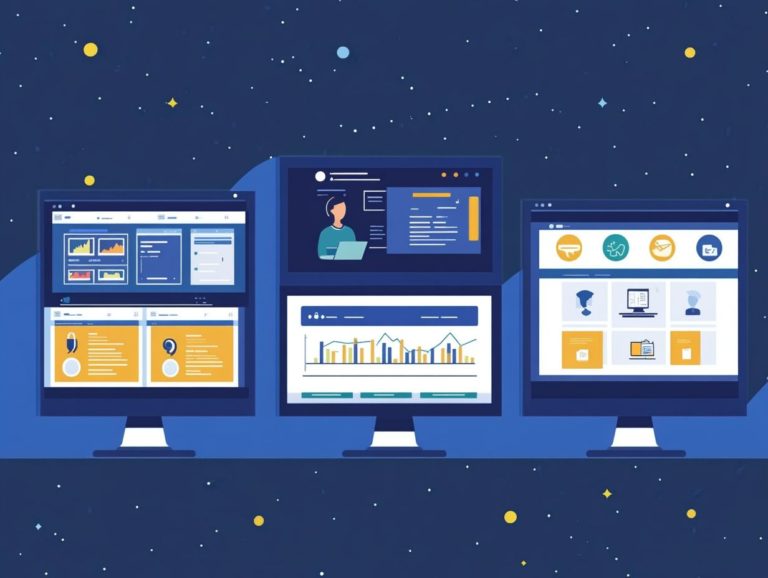Navigating SaaS Licensing: What You Need to Know
In today’s digital landscape, Software as a Service (SaaS) has reshaped how you access and manage software solutions for your business.
Understanding SaaS licensing is essential for maximizing the value of your investment and ensuring you select the model that aligns best with your needs.
This article guides you through the various types of SaaS licenses, from per-user to per-feature options, while emphasizing crucial factors to consider in your decision-making process.
You ll uncover common pitfalls to avoid and discover best practices for effective license management.
Get ready to make informed decisions that will propel your organization s growth.
Contents
- Key Takeaways:
- Understanding SaaS Licensing
- Types of SaaS Licenses
- Factors to Consider When Choosing a SaaS License
- Common Mistakes to Avoid
- Managing SaaS Licenses
- Frequently Asked Questions
- What is SaaS licensing and why is it important?
- What are some common types of SaaS licenses?
- How can I choose the right SaaS license for my business?
- What should I consider when negotiating a SaaS license agreement?
- Can I change my SaaS license agreement after signing?
- What happens if I violate my SaaS license agreement?
Key Takeaways:

- Know the different types of SaaS licenses: per-user, per-device, and per-feature.
- Consider factors like usage, scalability, and pricing models for cost-effective choices.
- Avoid overpaying for features you don t use and regularly review your licenses for savings.
Understanding SaaS Licensing
Understanding SaaS licensing is essential for any business aiming to harness software as a service (SaaS) to streamline operations and cut costs.
As your organization increasingly turns to online solutions to meet customer needs, mastering software licensing complexities is key to effective contract management and compliance.
Selecting the right SaaS license ensures that you access products aligned with your business goals while optimizing vendor performance.
Let s explore the exciting world of SaaS agreements, including types of licenses, pricing strategies, and best practices tailored for procurement teams like yours.
What is SaaS and How Does it Work?
Software as a Service (SaaS) lets you access applications online, so you don t need to install them on your computer.
With this model, you typically subscribe to the software, giving you the flexibility and scalability needed for your unique business requirements. This approach minimizes upfront costs tied to purchasing hardware and simplifies maintenance and updates since providers handle these tasks in the cloud, allowing you to focus on what truly matters.
Businesses across sectors, from healthcare to finance and education, increasingly recognize the advantages of SaaS applications. They offer mobile accessibility and collaboration features that traditional software often lacks.
By embracing SaaS solutions, you can accelerate your digital transformation journey, streamline operations, enhance customer experiences, and drive improved efficiency and innovation within your organization.
Types of SaaS Licenses
Understanding the different types of SaaS licenses is crucial for organizations like yours that seek to optimize software costs while aligning licensing strategies with customer needs.
Each SaaS license whether per-user, usage-based, or enterprise has unique characteristics, advantages, and limitations. Understanding these can profoundly influence your contract management and overall access to software.
Per-User Licensing
Per-user licensing allows you to pay for each individual using the software, making it a smart choice for managing costs.
This approach is particularly advantageous for organizations with fluctuating workforce sizes or diverse software needs, providing the flexibility to scale licenses based on actual usage. You only pay for what you require, promoting accountability and optimal resource allocation within teams.
However, for larger enterprises, this model can lead to unexpectedly rising costs, especially if the user count increases significantly. It also requires diligent software management to track active subscriptions and ensure compliance with vendor licensing terms, impacting your overall cost management strategy.
Per-Device Licensing

Per-device licensing allows you to purchase software licenses based on the number of devices accessing the application. This model is particularly advantageous for your organization, especially if you experience fluctuating user counts or have remote work arrangements.
This approach can be beneficial for industries such as manufacturing, healthcare, and education, where the number of devices may vary due to project demands or seasonal fluctuations.
Unlike user-based licensing, which ties access to individual users, per-device licensing offers you the flexibility needed for shared devices in collaborative environments.
It stands in stark contrast to enterprise licensing, which allows a company to provide access to many users, often at a flat rate. Enterprise licensing often results in a static cost that might not accurately reflect your actual usage.
You ll want to evaluate your specific needs to determine if per-device licensing is the most cost-effective and efficient solution for your operational requirements.
Per-Feature Licensing
Per-feature licensing offers you the flexibility to pay only for the specific features of a software application that you actually use. This allows for a more tailored pricing strategy that aligns perfectly with your business needs.
This approach can lead to significant cost savings, especially if you belong to a smaller company that doesn t require extensive functionalities. However, it comes with its own set of challenges, such as managing various service-level agreements.
You might find the experience somewhat disjointed if you have to toggle between different features or modules, which could ultimately affect your satisfaction. You need to carefully assess which features you truly need to avoid unnecessary expenses, underscoring the importance of strategic analysis during implementation.
Balancing these considerations is crucial for maximizing the benefits of this flexible licensing model.
Factors to Consider When Choosing a SaaS License
Choosing the right SaaS license is crucial. It can save you money and streamline your operations while taking into account several key factors such as contract terms, pricing models, scalability, and your organization s specific needs.
Understanding how these elements interconnect can profoundly impact your software management decisions and ultimately shape your overall software expenses.
Usage and Scalability
Usage and scalability are paramount in SaaS licensing, as they significantly influence how you utilize software and manage the associated costs of access and features. Understanding these factors is key for optimizing your software investments while preparing for future growth.
By embracing a usage-based licensing model, you can adjust your software expenses in line with actual usage, rather than being locked into fixed fees that may not align with your evolving requirements. This flexible pricing strategy fosters better alignment with your organization’s growth and project expansion, encouraging responsible consumption and potentially leading to considerable cost savings.
As your company scales, having a licensing approach that adapts to fluctuating demands becomes essential for maintaining efficiency and ensuring that resources are allocated wisely.
Contract Terms and Pricing Models
The contract terms and pricing models associated with SaaS licenses play a crucial role in shaping the software agreements you enter into, significantly impacting your cost control and service-level agreements.
Understanding the nuances within these agreements is vital for maximizing value and minimizing risk. Pay particular attention to renewal approvals, as they often come with automatic renewal clauses that could lead to unexpected costs.
Compliance terms are equally important, as they dictate how you must adhere to software regulations to avoid penalties. The choice of pricing models, whether subscription-based or usage-based, can greatly influence your cash flow and operational capabilities.
Each model offers unique benefits, carrying implications for budgeting and forecasting. Stay informed about contract terms to avoid hidden costs. Knowledge is your best ally in SaaS licensing.
Common Mistakes to Avoid

Avoiding common mistakes in Software as a Service (SaaS) licensing can save your organization money and build stronger customer relationships.
Overpaying for unused features or ignoring future needs can lead to high costs and poor software management.
It s crucial to plan your licensing strategy carefully to get the best value and minimize waste.
Overpaying for Unused Features
Many businesses make the mistake of paying for features they don t use, which can lead to unnecessary expenses.
To understand your actual usage, use the software s analytics tools or conduct regular checks to see how your team uses various features.
Compare these findings with your current licensing agreements to find out which features are genuinely useful.
Talk to your SaaS providers about pricing options. You can explore tiered pricing or negotiate plans that fit your actual usage.
Not Considering Future Needs
Ignoring future needs when choosing a SaaS license can misalign your software management with business growth.
If you expect to grow, avoid licenses with limited user access or features. Such choices can lead to costly upgrades later.
Look for licenses that offer flexibility so you can adjust as your needs change.
Managing SaaS Licenses
Managing SaaS licenses effectively is key to controlling software costs and ensuring compliance.
Establish clear practices, track your software inventory, and create strong renewal approval processes.
Best Practices for License Management
Adopting best practices for license management helps maximize your SaaS licenses while enhancing software access.
Regular audits can identify underused subscriptions and reduce unnecessary costs. Tracking usage provides insights into efficiency.
Engaging proactively with vendors strengthens relationships and gives you leverage for better terms.
These strategies optimize your software investments and ensure compliance, contributing to a more efficient operation.
Key Takeaways and Final Thoughts

Understanding key takeaways about SaaS licenses is crucial. This knowledge helps you navigate software management and boost vendor performance.
Grasp compliance terms to avoid costly penalties. It ensures your software usage aligns with legal requirements.
Be aware of renewal processes for these licenses. Missing key deadlines can cause service interruptions and unexpected costs.
Establish a systematic approach to monitoring your licenses. This not only safeguards your investments but also streamlines operations.
Informed decisions on SaaS subscriptions maximize your value. They also help build stronger relationships with service providers.
Frequently Asked Questions
What is SaaS licensing and why is it important?
SaaS licensing sets the rules for using software that s hosted online. It defines how you can use the software and what you have to pay.
What are some common types of SaaS licenses?
Common types include subscription, usage-based, per user, and per feature licenses. Each type has different pricing and usage options, which is why it s important to find the one that fits your needs.
How can I choose the right SaaS license for my business?
To choose the best SaaS license, assess your specific needs. Think about the number of users, how often you use the software, and any special features you might require.
What should I consider when negotiating a SaaS license agreement?
Focus on pricing, usage restrictions, data security, support, and termination terms. Make sure to clear up any confusing terms and ensure the agreement meets your business goals.
Can I change my SaaS license agreement after signing?
You can often make changes after signing, but it depends on the agreement’s terms. Review the document and discuss any changes with the provider.
What happens if I violate my SaaS license agreement?
If you violate the agreement, the provider might terminate your access. This can lead to lost data and disrupt your business, so always adhere to the terms to avoid issues.





